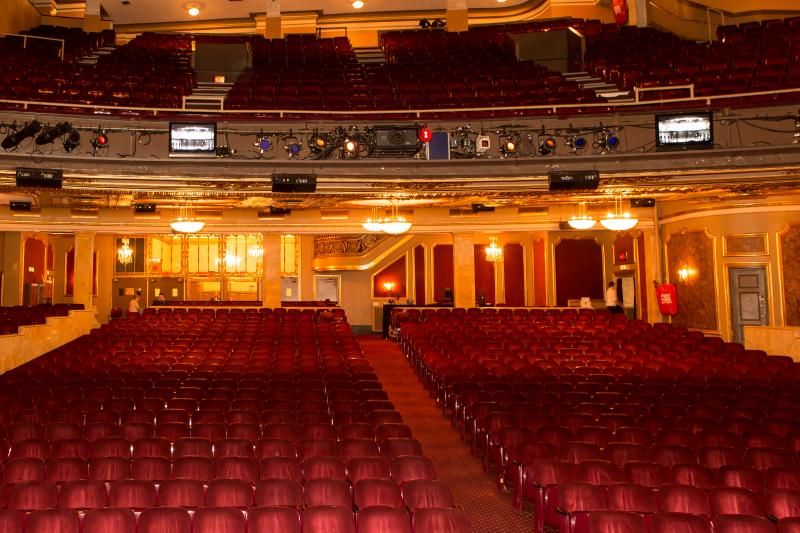BWW Exclusive: New York's Palace Theatre- The Valhalla of Vaudeville
Only a vaudevillian who has trod its stage can really tell you about it. Audiences can tell you about who they saw there and how they enjoyed them, but only a performer can describe the anxieties, the joys, the anticipation, and the exultation of a week's engagement at the Palace. The walk through the iron gate on 47th Street through the courtyard to the stage door, was the cum laude walk to a show business diploma. A feeling of ecstasy came with the knowledge that this was the Palace, the epitome of the more than 15,000 vaudeville theatres in America, and the realization that you have been selected to play it. Of all the thousands upon thousands of vaudeville performers in the business, you are there. This was a dream fulfilled; this was the pinnacle of variety success.

Built in 1913 as the flagship for the big time vaudeville circuit run by E.F. Albee and Martin Beck, manager of the Western Vaudeville Managers Association, the Palace was the perfect showplace for the biggest of big time vaudeville during the last two decades of its existence.
The Palace was a show business Mecca. All the top acts would play there: Bob Hope, Eddie Cantor, Sophie Tucker, the Marx Brothers, Burns and Allen, Nora Bayes, Smith and Dale, Frank Fay, Jack Benny, Eva Tanguay, George Jessel, Weber and Fields, Cliff Edwards, Phil Baker, Bill Robinson, Fanny Brice...the list goes on and on. The Palace was a cherished showcase gig because the audience was full of bookers, scouts, agents, and fellow performers. Comedian Ed Lowry said opening day at the Palace was as exciting as the Kentucky Derby. The sidewalk out front, called the Palace "beach" was a popular hangout for industry professionals looking to network. For a vaudevillian, to have "played the Palace" was to have died and gone to heaven. Which is why that expression lives on in popular idiom, long after anyone even remembers what it used to mean.
The Palace became the focal point of a new twentieth-century aesthetic of snazz, of pizazz, of (as Variety abbreviated it) "show biz". It reigned supreme until vaudeville was no more. Most folks measure the death of vaudeville from the time the Palace played its last two-a-day in 1932. Getting to that point was gradual. In 1929 Joseph Kennedy (yes, the President's father) engineered an aggressive merger of the Keith-Albee-Orpheum vaudeville chain (of which the Palace was the flagship) with RCA (principally a radio network and record company) and Film Booking Office. The new combine became Radio-Keith-Orpheum, or R.K.O.
After that, various combinations of film and variety bills were tried, on and off, over the next quarter century. In the 1950s, there were successful vaudeville revivals there headlined by the likes of Judy Garland, Frank Sinatra, Danny Kaye, Jerry Lewis and Betty Hutton. It was still the RKO flagship venue, though, so important movie premieres were held there, perhaps most famously Orson Welles' Citizen Kane in 1941. From 1957 through the next decade (with the exception of one brief Harry Belafonte engagement) the Palace was exclusively a cinema -- ironic, given that RKO Pictures ceased production around the same time.

In 1948, it also hosted the opening of WJZ-TV, ABC's New York flagship (these call letters were purchased by a Baltimore station a few years later).
In 1966, The Nederlander Organization acquired it and it became primarily a venue for live Broadway theatre again. Through a series of transactions, Stewart F. Lane was able to acquire fifty percent ownership of the Palace in 1981. In 1989, a hotel (currently Hilton's Doubletree Suites) was built over the theatre, but the interior itself remains as glorious and glamorous as ever. Large billboards now obscure its Times Square side facade. But this historic venue still goes strong. The past half-century has seen the original productions of such shows as: Sweet Charity (1966-67), George M! (1968-69), Applause (1970-1972), Lorelei (1974), Woman of the Year (1981-83), La Cage aux Folles (1983-87), The Will Rogers Follies (1991-1993), Beauty and The Beast (1994-1999), Aida (2000-2004), Legally Blonde (2007-2008), and Priscilla Queen of the Desert (2011-12), and concerts by the likes of Liza Minnelli, Bette Midler, Diana Ross, Shirley MacLaine and Beatlemania. And numerous successful revivals.
A venue perpetually reinventing itself, we can be sure that, as it enters its second century, the Palace will reinvent itself many times again in the years to come.
Trav S.D. has written over 300 articles for publications such as the New York Times, Village Voice, Time Out New York, the New York Sun, American Theater (where he was an Affiliated Writing Fellow in 2001), Reason, and many others. Since 2008, he has also written the popular arts and culture blog Travalanche. He is also the author of the popular show biz books No Applause, Just Throw Money: The Book That Made vaudeville Famous (2005) and Chain of Fools: Silent Comedy and Its Legacies from Nickelodeons to Youtube (2013).
Photo Credit: Matthew Peyton Photography
Videos

